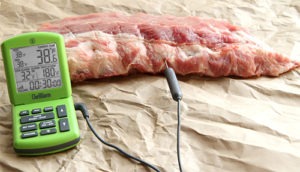what temp do pork ribs need to be
Father's Day is hither, and we all know what that means… BBQs will be out and ribs will be fired up across the nation. But that leads us to the historic period-old question. When do you know the ribs are done? Ignore the USDA safety temperatures. Baby Back Ribs may exist safety to eat at 145°F only they won't exist tender or every bit flavorful as they should be. The collagen and fatty have not however melted into the meat. Connective tissues will be inedibly tough.
It is widely agreed that ribs are done between 180°F and 195°F. Some experts are even more precise and telephone call for a variance of plus or minus only two or three degrees. Virtually all agree that temperature, and time at temperature, are the best gauges of rib "doneness." However, getting an authentic or useful temperature measurement is hard with ribs. The first problem is the number and mass of bones relative to meat. The infinite between bones tin can be narrow. And the thickness of the meat there is too narrow. A thermometer reading that is also close to the os volition exist unlike than the temperature at the centre of the meat. Most instant read and alarm thermometers have probes that are besides large in diameter to go an accurate reading in rib meat. It tin besides exist a claiming to maneuver the probe between the bones.
The difficulty of getting a good temperature reading has contributed to the propagation of BBQ lore surrounding other "tests" for rib doneness. Hither are just a few: the time examination, the tong test, the twist test, the popup test, the pullback test, the peek-a-boo test, the toothpick test, the manual separation exam, the meat colour test, and the fall-off-the-bone examination. This is where mythology volition mess you up. Several of these are not considered reliable, all are bailiwick to personal interpretation and some are just wrong. The most mutual may be the fall-off-the-os test. Now you may similar yours this way and that's merely fine. But a existent rib connoisseur will tell you yous're missing nirvana.
The most respected non-temperature rib test is employed on the professional competition circuit by the likes of theKCBS Certified Competition BBQ judges and is called the bite exam. What's great nearly this benchmark for a great rib is that anyone can practise information technology. You simply take a seize with teeth out of the rib. If you tin meet where y'all took a bite – they're perfect. If the meat falls off the os – you've over cooked them. Now, what's not so great about this benchmark is the fact that you just took a bite. Now you can't serve that rib! Now that may not carp you but especially when learning to melt ribs, you could be taking more bites than you originally thought and soon one-half your ribs are gone.

Enter the ThermoWorksChefAlarm® with the Pro-Serial Needle Probe. The Needle Probe is a peculiarly made thermistor probe (1/16th of an inch all the way up the shaft) that is tiny enough to fit between the bones of even baby back ribs to requite you an accurate reading of the meat. Outside of an expensive professional thermocouple system, this is the only alarm probe that is sparse enough to practice this chore. Simply position the probe tip in between two ribs at the center of the rack. Brand sure your probe tip is immersed vertically to the halfway betoken of the bones and centered in the thickness of the meat. Set the ChefAlarm High Warning to 180°F. Cook your ribs depression and slow. When the alarm sounds, set the timer for at least 30 minutes and brand sure the ribs stay between 180°F and 195°F until the time is up. The ribs should now meet the competition BBQ bite test.
When talking rib cooking temperatures, Meathead from AmazingRibs.com has this to say,
The ideal cooking temp is almost 225°F, hot enough to chocolate-brown the surface, to develop a crusty bark, and to melt fatty and collagens. On most cookers, when the oven temp is 225°F at sea level, it takes nearly three to four hours to melt a slab of baby backs and virtually v to half dozen hours to cook a slab of St. Louis cutting ribs or spares.
They areslightly undercooked at that stage. I then put the sauce on and sizzle it in on a hot grill for about five minutes per side. This finishes the cooking and makes sweet sauces sense of taste their best. But you have to stand there and watch them so the sauce won't burn. If you skip the sizzling stride, add another xxx minutes of cooking time at 225°F.
At higher cooking temperatures subtract the cooking time, for example, at 325°F, baby backs tin be done in merely 90 minutes, just there will exist shrinkage and they will be tougher. At higher altitudes, increase the cooking time 20% or more. The fundamental here is to keep the cooking temp under control, and that is the charcoal-broil chef's craft.
As Meathead mentions, monitoring your melt heat is critical to not rushing nor overcooking the ribs. The ChefAlarm also offers aPro-Series High Temp Air Probe for that exact purpose. A second ChefAlarm tin be set to rail the exact internal temperature of your cooker at all times. The constantly displayed Max and Min temperatures show you the cooker performance. High and low alarms could be prepare to warn you lot if the heat needs adjustment. With this noesis, you lot can perfectly control how your meat is cooked.
Happy Father'southward Day!
Source: https://blog.thermoworks.com/pork/ribs/
